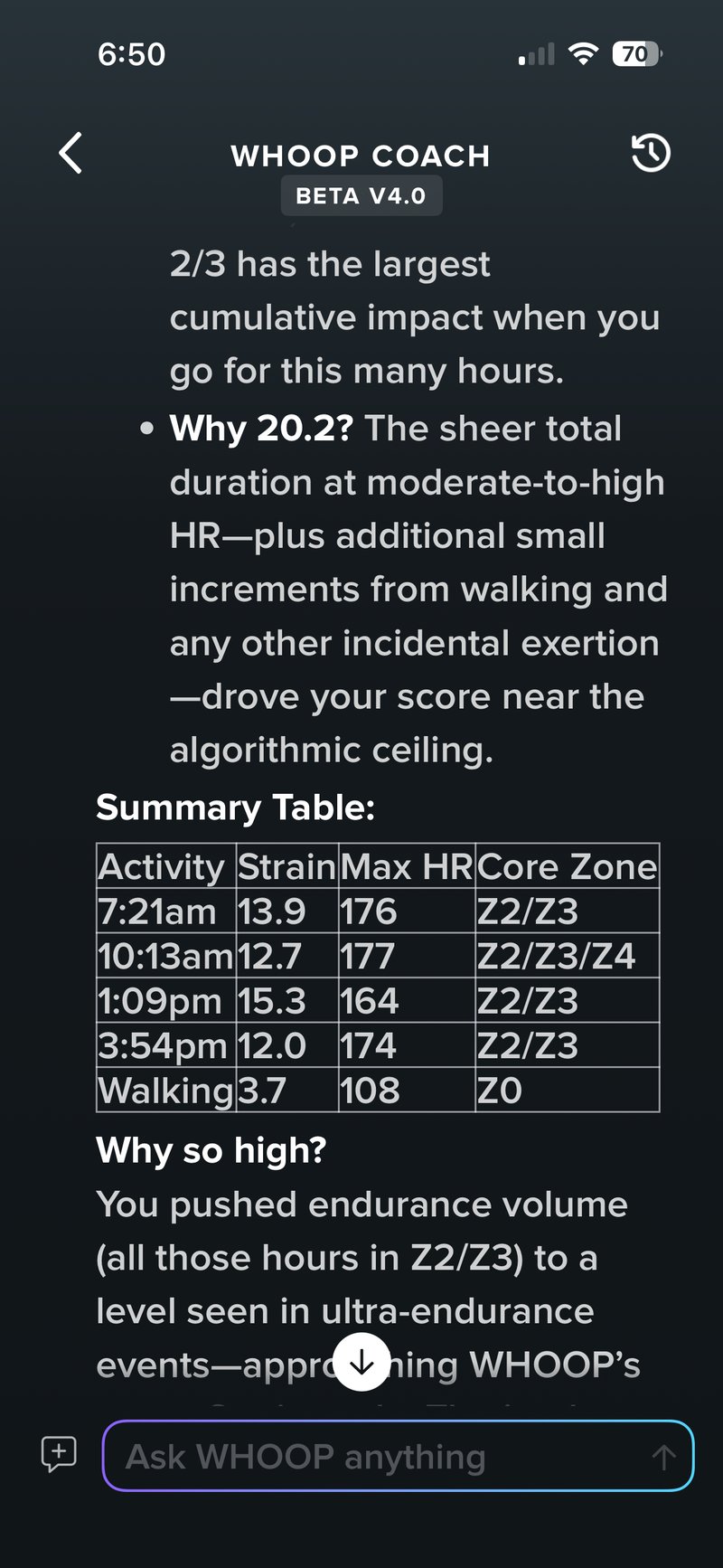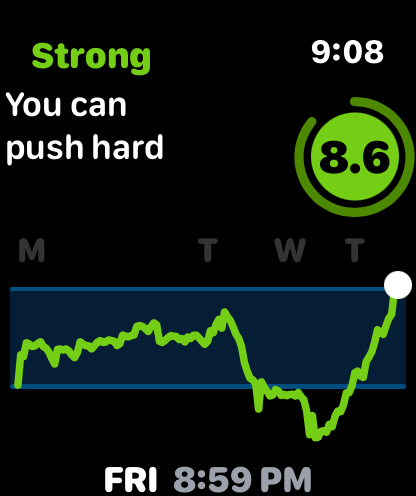 Whoop Strain 20.2 – here’s how I did it, and so what?
Whoop Strain 20.2 – here’s how I did it, and so what?
This article looks at how I got a Whoop stain score of 20.2 (out of 21). It starts with an explanation of the day’s exercise and then deep-dive into the calculations.
London to Brighton…and back
Last month, we had our annual ride from London to Brighton and back. It’s technically a Century ride, meaning it’s over 100 miles (170km). More correctly, we see it as a four-part combo ride—three coffee segments with a beer segment at the end.
A few annual regulars dropped out, and two relative newcomers to our cycling group tagged along. It was very much a “Wahoo ride” with all of us using Wahoo bike computers of varying ages – mainly because ‘they work’ except when, recently, they didn’t. Or at least some of them didn’t.
To the newcomers, my array of watches and heart rate gadgets, two power meters and every possible cycling electronic gadget gives the game away that I’m either a bit weird or have an unhealthy love of cycling gadgets. Or both.
My main tech annoyance from the ride was that it’s hard to remember to charge up all the various electronics, especially for a day-long affair where even a modest charge will soon be insufficient to complete the day. With a flat battery, you soon miss a helpful beep from Varia Radar before someone passes too close in a car. Grrr.
Post-ride, my interest turned to the stats. How many Strava PRs did I bag, and was it my fastest time up Ditchling Beacon? The respective answers being “over a hundred” and “No”. While it was nowhere near our quickest Brighton ride overall because of the stops, it was still a hard day in the saddle. But how hard?
I consulted the Whoop app for its take.
the Whoop Strain Score
Whoop has a proprietary strain score, which ranks your effort out of 21. Invariably, if you get a 21, you’ve either set your zones incorrectly or the heart rate readings were wrong (too high).
The BORG RPE scale is scored out of 20, so Whoop having a top score of 21 is equally as odd if you are looking for every scoring system to be based off 10. But, hey, 21 is as good a top number as any other, and it’s literally an odd number too!
The 0-21 scale is widely disliked by many who comment on the fitness industry and many Whoop owners. One good thing about the scale is that it is a bounded logarithmic scale, meaning you can’t score 22 or 23 or 24, and it’s harder to get from 19 to 20 than it is to get from 9 to 10. Also, it limits what you can achieve to some extent and might stop the inevitable STRAIN-seekers from overtraining – contrast that to a normal TRIMP score, where the more you do, the higher it gets.
Anyway, I got a 20.2.
Q: Did you win a prize?
A: No.
20.2 is pretty high. I would have guessed it would be an 18 or a 19. I’ve cycled 200 miles relatively recently (twice as far), so I’m pretty sure I could have kept going for at least another 50 miles had there not been a pub in the way. Which there was. And I was tired.
So, I’m not quite sure why the score was so high. I wore Whoop on my biceps, and the HR data appears accurate.
For the HRmax component of the calculation, WHOOP uses Gellish’s non-linear formula, 192 – 0.007 × age² – the Tanaka formula 208 – 0.7 × age might be better – then refines the Gellish Score as it learns your data. Whoop Coach says that my HRmax is currently 178 bpm and that it has ignored two recent occurrences when a 189 bpm was assumed to be a data error by the app. That’s pretty good. Garmin, by coincidence, has my HRmax as 178 (or it might be 177), whereas I thought the reality was a bit lower for cycling (174), but I may have gone over that in the last month, and so a maximum is what it is. Good job, Garmin and Whoop.
So my data and parameters are probably Ok.
Here is how the score was made up. Handily, because of the coffee stops, Whoop recorded four separate rides, and I also took the dog for a 4km walk when I got home. Here is the very basic math on the STRAIN: 13.9 + 12.7 + 15.3 + 12.0 + 3.7 = 20.2
Before the walk, Strain was 20.1, so the 3.7 strain for a dog walk added 0.1 (fair enough). However, during a digital chat with the app, the Whoop Coach told me that a further 3 hours at Strain 16.0 would have only added 0.5 at most. This is odd due to what the very leisurely dog walk added.
I sorta get this, and it might be how it works, but it doesn’t feel quite right. It would feel more right to me that the four main rides added up to about 18 or 19, and then a further 3 hours ride (that I didn’t do but could have) would have added 1.0 or 2.0.
What do you think?
Aside: Whoop Coach – Look at the image above. That shows the end of a relatively intelligent chat I had with with the Whoop AI coach. The Coach is a bit wordy sometimes, but it held a sensible conversation about my data, the science and the way Whoop interprets it. With Strava and Garmin, it’s more, “Yay, you tried really hard today, well done. Please, can we have your subscription money?“
HRV
I’ve written a few things recently about HRV. Mostly to help those who don’t understand HRV to understand!
Garmin Body Battery slammed indirectly by Altini: “Made Up Scores”
So, I’ve just shown you a very hard ride. I think 99.5% of people reading this article would say that a 100-mile ride is very hard and probably find it very hard to do themselves.
After the ride, my HRV will fall like crazy, right? All that strain? Strain is stress. Stress is high. My HRV must crash. And I had a beer as well. It must have really crashed? No?
Nope. That’s not how it works. As you can see, I finished my last ride at 5 PM and my HRV rose until midnight according to Training Today on the Apple Watch (based on individual, 10-15 minute HRV readings).
The HRV shows that I can handle the high strain (fair enough; I’m fit) and my beer (fair enough; I’ve only had two pints).
I’m not entirely convinced that Training Today/Apple Watch presents the most useful Body Battery-like image for the following morning (image with red line). In any case, it’s looking at my resting physiology, not my exercise physiology. They’re different.
My HRV4Training waking test (one minute, seated) showed that my HRV was within the normal range, but I could just about train. So I did a sneaky 7km recovery run (again with the dog) and another 5km dog walk. Yes, I have a very fit dog.
Take Out
So, the moral of this sweaty story is threefold
- Charge your gadgets. Varia Radar cannot work on air. It needs the juice from the power sockets.
- A fit person should see HRV rise after exercise. HRV is a measure of how you are coping. Some Body-Battery-like algorithms that use multiple data points will see the massive strain/TRIMP and force a trend downwards. Why? (A: Because they are made up composite metrics)
- I don’t have an issue with Whoop’s maximum score of 21 but it feels wrong that I get so close to it after a very hard day, especially considering that I could probably have kept going for hours more yet would only have scored less than one point for those additional hours. On a related note, your data or settings are wrong if you got a Whoop strain score of 21. Obviously, my score of 20 is real and correct 😉
Joking, of course. Please feel free to post your dog pics below if you can figure out how the comments section works for adding media.





